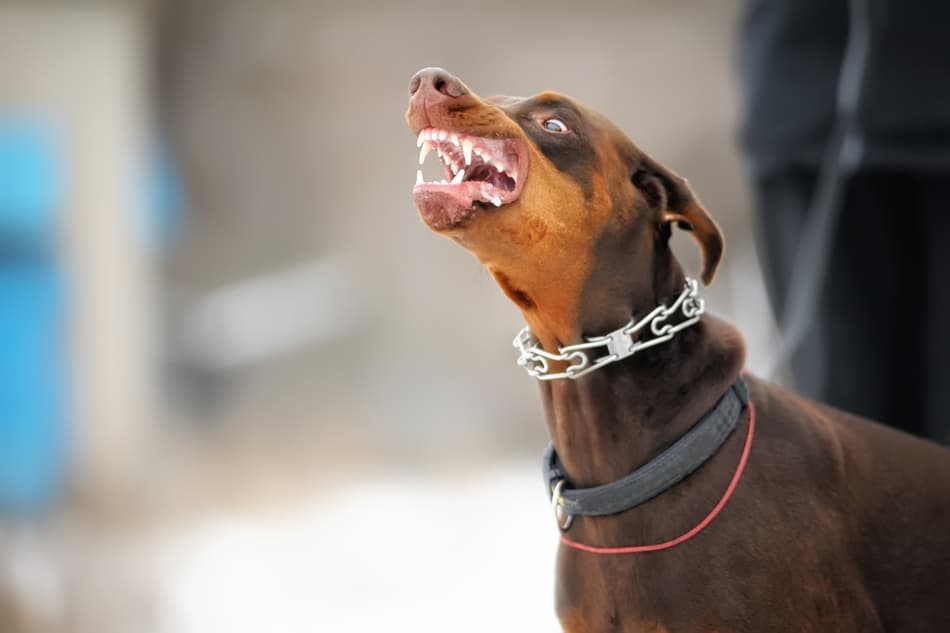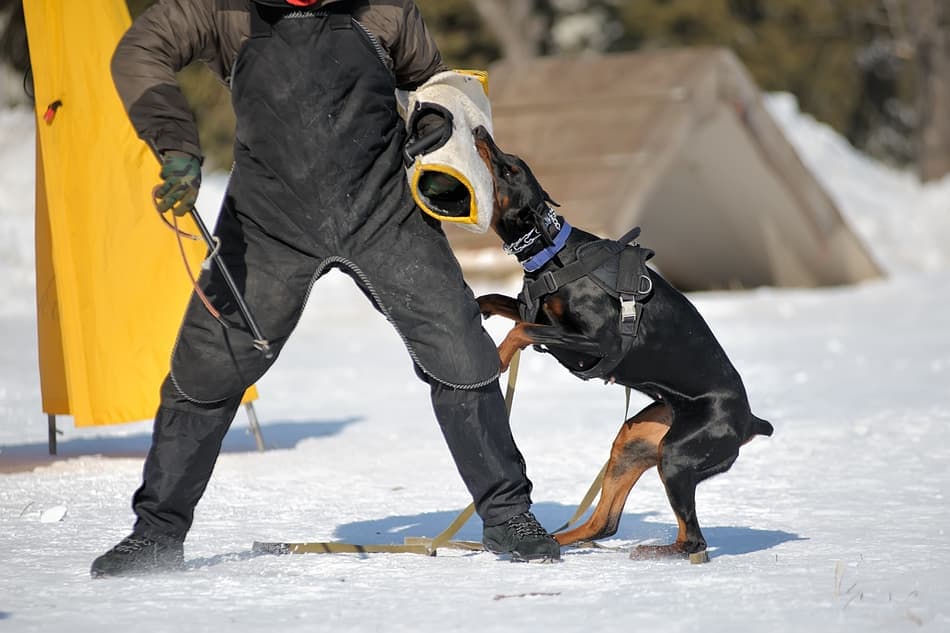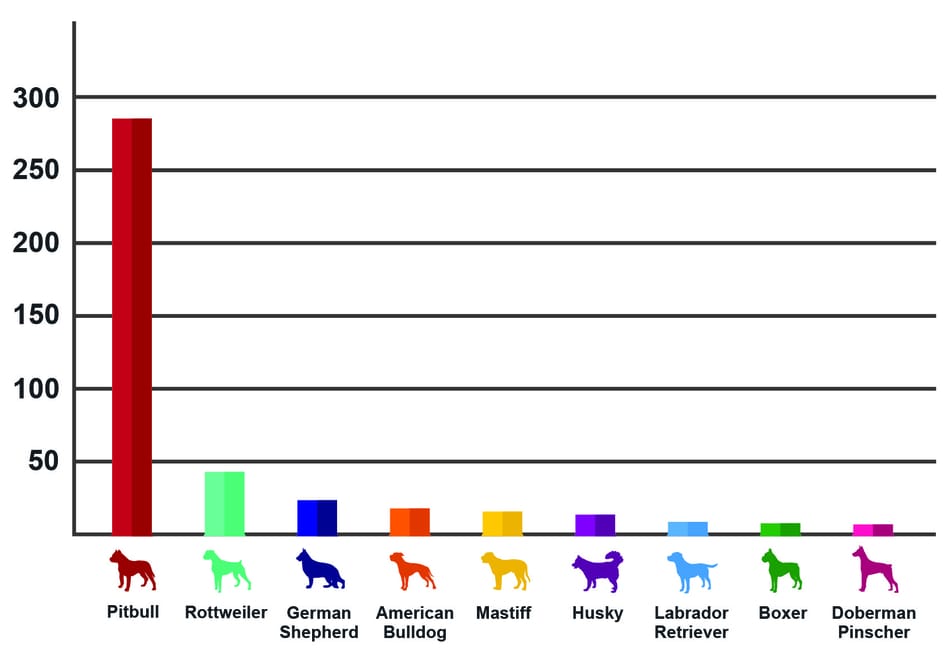
Owning a Doberman Pinscher is a truly unique experience. It’s very common to be approached by other people out in public who want to talk about your beautiful, proud, noble-looking dog. People have many questions about Dobermans when they see one, but the most common questions have to do with how aggressive or dangerous Dobermans are. In fact, many people have told me they thought these dogs were just plain mean.
With years of experience and involvement in the Doberman community, I feel I can answer that question with confidence. It’s time to set the record straight so people will know the truth about this impressive breed, and not just what the movies tell them.
Physical Traits
Dobermans are built to work in a personal protection role. Because of this, it’s easy to see how many people see them as potentially overly aggressive and dangerous. Just looking at these dogs can strike fear into many people, and frankly, it’s understandable.
They have many physical features that were originally bred into these dogs to help them perform their desired role. These are some of the physical traits that help them excel in the role of personal protection.
- Large: These dogs are on the larger side, but not so big that their size will interfere with their agility. Males average between 75 to 100 pounds and 26 to 28 inches tall, while females average between 60 to 90 pounds and 24 and 26 inches tall.
- Muscular Build: With low body fat and a muscular build, they’re built for speed, strength, and stamina. In fact, they can run up to 40 mph and maintain these high speeds for an impressive length of time—thank you greyhound genes!
- Broad Powerful Chest: A broad muscular chest is perfect for hitting large prey hard and taking them to the ground.
- Proud Posture: Dobermans have a unique posture that makes them stand out from other breeds. They sit tall, alert, calm, and proud. They are known for looking people directly in the eyes and not breaking eye contact.
- Blunt Wedge Shaped Head: The head itself is considered to be a blunt wedge shape, but a large portion of the head’s profile view is taken up by the dog’s powerful jaws and
large mouth . - Cropped Ears: Traditionally, Dobermans have cropped ears that stand straight up. There are many reasons for this, but some of the original purposes of the erect, cropped ears were to help locate the source of sound during guard work and to eliminate a potential handhold on the dog and prevent damage during a fight. Erect ears are more difficult to grab than floppy ones.
- Short Sleek Coat: Their sleek short coats certainly makes the dog more difficult to hold onto or control in a fight.
- Docked Tail: Their natural tails are long, thin, and prone to breaking. Thes tail also provides another way for a potential attacker to get ahold of the dog. This is why they traditionally have docked tails.
These physical traits make the Doberman have a distinct look that often strikes fear into people who aren’t familiar with the breed. These dogs are very often incredibly gentle and not as dangerous as they look. Unfortunately, this unique combination of physical characteristics make them the perfect “villain dog” in movies and television, and they’re often portrayed as such.
General Temperament
In addition to the physical traits listed above, there are also many typical temperament traits that help to make the Doberman a great guard dog. Just like with the physical traits, the casual observer may see some of these as a sign that the dog is dangerous to be around. However, that’s far from the reality.
- Reserved with Strangers: By nature, Dobermans are a little reserved with people that they don’t know, at least initially. After a short time, and once they decide that you’re not a threat, you’re likely to see a very warm side of the dog.
- Protective of their Owners: They have a natural instinct to protect their owners. After all, this is what they were bred to do over a hundred years ago. If they sense something is wrong, they’ll act. This is true of even the most docile Doberman in my experience. For example, if a stranger closely approaches you with a large object (like a rake or large stick) while you’re out for a walk with your Dobie, talks loudly, and moves their hands abruptly as they speak, it wouldn’t be surprising for the dog to become agitated and warn the subject with a series of loud barking.
- Loyal: These dogs are incredibly loyal, and love to stick by the side of their owners. That’s why they’re often referred to as “velcro dogs.” They love their owners and will defend them to the death. They’re also very in-tune with people and tend to bond strongly to one specific member of their family, yet they’re still content being “part of the pack” of the family as a whole.
- Intelligent: Dobermans are consistently ranked among the smartest dog breeds in the world. They’re great at problem-solving, following commands, and understanding what is expected of them. It’s because of their extreme intelligence that they’re also considered one of the most trainable dogs in the world.
They do possess a number of other impressive temperament traits that really makes them great family dogs. Read Are Dobermans Good Family Dogs for more information on exactly why Dobermans really do make an amazing family pet.
Unfortunately, many people will see a large, impressive, noble-looking dog sticking close to their owner’s side and will assume that they must be aggressive or just mean. Some even think that every Doberman should wear a muzzle all the time. This is far from reality.
A well-socialized Doberman is an extremely loving and gentle dog and they’re even often used as service dogs due to their intelligence, trainability, and kind nature.
The Scissor Bite
One of the common reasons people see Dobermans as ferocious is
In addition to the strength of their bite, Dobermans also have what’s called a “scissor” bite. This means that their teeth come together in a fairly precise, interlaced way (like interlacing your fingers) as they bite down. This allows them to hold onto what they bite very effectively. It also allows them to cut through objects with ease.
Lastly, the Doberman tends to bite in a fairly unique way. Whereas the American pit bull terrier is known for biting down and refusing to release, the Doberman does the opposite. They tend to bite, release, and re-bite in very rapid succession. This rapid biting movement inflicts a significant amount of damage in a very short period of time.
Have I scared you yet? Well, you really shouldn’t be. Although Dobermans have impressive abilities, they’re not likely to use them unless they’re threatened. In fact, the modern-day Doberman is known to be gentle, kind, and great with kids. This wasn’t always the case though.

How Dobermans Were Bred to Protect
Yes, the Doberman breed is man-made. In fact, they’re a fairly recent creation and only came to be a little over a hundred years ago. Understanding why and how they were created will shed light on why they behave the way they do. Quite simply—it’s in their genetics!
During the late 1800s, Karl Friedrich Louis Dobermann lived in Apolda, Germany. He worked at least two jobs at that time. He was the town’s tax collector (a fairly unpopular position), and he ran the local dog pound where he had access to dogs of many different breeds. Louis decided he needed a dog to accompany him on his rounds through the town collecting taxes for his own safety. Louis set out to produce the perfect dog for personal protection through selective breeding. He did this by using the various dogs he had access to at the dog pound.
Louis needed to produce a dog that was strong, fast, smart, fearless, completely loyal and very trainable. The dog also had to be large and intimidating to discourage potential attackers, as well as truly ferocious if need be. Louis set out experimenting by selectively breeding dogs and after many generations, he ended up with the Doberman Pinscher—the perfect protector.
Louis never documented exactly which dogs he used to produce the Doberman, but it’s commonly believed that he used some combination of the greyhound, rottweiler, German shepherd, great dane, German pinscher, English greyhound shorthaired shepherd, Weimaraner, Beauceron and black and tan terrier (which is now extinct, but is an ancestor to the Manchester terrier).
DID YOU KNOW?
The European Doberman is a much closer relation to Louis Dobermann’s original dog than the American variant. Read my article all about the differences between the European and American Doberman here.
Modern-Day Dobermans
In World War 2, Dobermans were used extensively by the United States Marine Corps during the various battles for control of the pacific. In the Battle of Guam, 25 Dobermans died serving their country in the battle against the Japanese. They were referred to as “Devil Dogs.”
The modern-day Doberman, is a far cry from the “Devil Dogs” of the past, however. They have far fewer aggressive traits than the Dobermans of many generations ago. The main reason for this is that modern breeders have bred out many of the aggressive traits from these dogs to make them more docile and better suited for a family environment.
Breeders are now breeding these dogs for companionship rolls much more often than guard duty rolls. They still retain their natural protective instincts and will certainly take action if necessary, yet they are very kind, loving, and predictable. All great qualities for a family pet.
Statistics: How Likely are Dobermans to Kill Someone?
According to a thirteen-year study which looked at the different breeds of dogs involved in fatal dog attacks, the Doberman ranked 11th. That’s pretty far down the list. Even the Labrador retriever killed more people during that period that Doberman’s did. So what kinds of dogs were involved in more deaths during the thirteen-year study? Take a look at the table below.

| Breed | Deaths | Percent of Total |
|---|---|---|
| Pit bull | 284 | 65.6% |
| Rottweiler | 45 | 10.4% |
| German shepherd | 20 | 4.6% |
| American bulldog | 15 | 3.5% |
| Mastiff (including bullmastiff) | 14 | 3.2% |
| Husky | 13 | 3% |
| Labrador retriever | 9 | 2.1% |
| Boxer | 7 | 1.6% |
| Doberman pinscher | 6 | 1.4% |
For a full breakdown of these statistics, including sources. Please see Dogsbite.org: U.S. Dog Bite Fatalities (2005 to 2017).
Did you know? There’s a common myth that Dobermans are prone to randomly snapping, and turning on their owners for no reason. Some say their brains grow too big for their skull size causing this viciousness. Is there any truth to this? Find out in my article Do Dobermans Turn on Their Owners? Brain vs. Skull Size Myth.
Are Dobermans Mean?
Doberman Pinschers are not mean by nature. They will generally only act out to protect themselves or their owners from a perceived danger. Any overly aggressive behavior from a Doberman is likely the result of a severe lack of socialization or mistreatment from their owner.
A lot of people ask me if Dobermans are mean. Asking if they’re mean is asking about their general state of mind and it’s not a straightforward answer. In general, no—I have not found Dobermans to be mean, but of course, there are always exceptions.
During my time offering consulting services to Doberman owners, I have come across a few dogs that appear to have a bit of a mean streak in them. But once you get down to the real root cause as to why they’re acting out and destroying things, trying to bite someone that comes to the door, or struggling from other behavioral issues, it’s not because they are mean. It is almost always related to their upbringing.
If a dog, any dog, isn’t socialized enough at a young age or lacks positive human interaction, it means that the dog will feel fear a lot more often. Even in what seems like normal, everyday situations to you and me and they may act out. Dobermans aren’t mean, but their owners can be.
Are Dobermans Dangerous?
While Doberman Pinschers certainly have the physical abilities to be quite dangerous animals, the modern-day Doberman is generally well suited for a companionship role and is not likely to be overly aggressive.
People will see a Doberman walking by with its owner and they’ll cross to the other side of the street. A father will pick up their toddler as they stroll past your leashed Doberman. The pool guy will be afraid to step in your backyard just by seeing your dog staring at him. Why does this happen? These people all believe that this is a dangerous breed.
I can tell you from personal experience that this is confusing to a Doberman owner. Especially when we often spend the evenings sitting on the couch with our dogs stretched out over our laps. Or tossing the ball endlessly for him. Dobermans are loving animals, yet they do have the physical ability to be dangerous if they need to be (they’re large, strong, and have a powerful bite). But they’re just great loyal protectors and are generally only dangerous to those threatening the ones they are close to.
Are Dobermans Aggressive?
Doberman Pinschers are instinctually much more protective than they are offensive or aggressive. They will generally only become aggressive while attempting to protect themselves or their owners from a perceived threat.
These dogs were bred to be protectors, that means they protect. They will stick close by your side and keep you safe at all costs. They generally don’t have any desire to pick a fight with a person or animal if they don’t feel threatened by them.
Of course, each dog has its own personality, but this is typical of the breed in general. They get their reputation because they can become ferocious if their owners are threatened, but honestly, isn’t that a good quality? I think so.
Reputation vs. Reality
While all the above questions are similar, they’re all asking something slightly different. No, Dobermans are not mean, yes they have the ability to be dangerous (but rarely are), and they are generally never aggressive without the need to protect either themselves or their owners. I am asked all three questions quite regularly when I’m in public with my dog.
The reason people want to know how aggressive these dogs are is because of what they see in movies and on television. The Doberman has been traditionally portrayed as the evil villain dog who will stop at nothing to attack anyone it sees. Luckily, this is just fiction. The reality is that these are wonderful family dogs, each with their own personality, but none of them “evil” at heart.
Related Questions
Do Dobermans attack their owners? It’s a common misconception that Doberman Pinschers are prone to turning on their owners. In fact, the modern-day Doberman is a great family pet that is very people-oriented and will protect their owners from harm, even at their own peril.
Are male or female Dobermans more aggressive? While every dog has its own personality, female Dobermans have a reputation for displaying more aggression than their male counterparts.
Are Dobermans aggressive towards strangers? Dobermans can be aggressive towards strangers, but this is usually only if they feel threatened or that their owners are in danger.
Are Dobermans aggressive towards other dogs? Dobermans can be aggressive towards other dogs, especially while on a leash. However early socialization can prevent this. Male Dobermans have also been known to have issues living with other male dogs in the same household.



Hello John, Max from Italy. Been owner of doberman in the passed, think best dog ever but don’t think that these statistics are good to be considered. In the 70s and 80s, if I’m right, doberman was at the first place because it was the dog that everybody had for guardian/defense and there was a lot of backyard breeders with no selection experience. Now it’s the pitbull time. Everywhere you look around you see Pitbulls then Rottweilers then German shepherd, dogo, corso ect, at least here in Italy. It’s rare to see dobermans around these days. I’ve had doberman, Rottweiler and now pit bull. All beautiful breeds if treated in the right way. I think Bad dogs do not exist. Only bad owners
These statistics are purely just the number of dog bite fatalities by breed that were reported. You’re right that it doesn’t account for the total number of dogs of each breed present in the U.S. so the stats are not adjusted for this. As far as I can tell, the stats for the total number of each breed of dog doesn’t exist.
Hey John. Great info and I enjoy your videos. You’re right on with the statistics. As a former police officer with over 30 years of experience , in my many years on the street – 90 percent of the dog attacks that I personally responded to involved Pit Bulls. I never once responded to a Doberman attack. Also as dog owner and trainer I can tell you that owning a Pit Bull is not worth the risk. In countless of situations I’d be met by the owner of the Pitt Bull and neighbors and they always said the same thing. “ He’s never been aggressive before”. Gimme a break. It’s not fair to the dog. The American Pit Bull has been bred for over 100 years to be extremely aggressive in reaction to pain. So when the child pull on it’s ear and the pit bull maims that child it’s what it was bred to do. So I don’t believe the notion that it’s always the owner. Some dogs are just bad. Like humans. Good luck and great work.
That statistics table needs some context regarding the number of dogs that there are in the area statistically studied compared to the number of incidents. A bit deceiving if you ask me. Pit-bulls have become very popular therefore they may be misunderstood at best.
Another thing would be: How are those dogs kept: Are they chained all the time? Do they exercise? Is the owner educated on how to train the dog? Not all dogs are suited for everybody. Not everybody can control a nervous-aggressive German shepherd for example.
I appreciate this! My doberman is the sweetest girl ever. While I’m sure she’d try to defend me (or herself) if threatened, her goal around most people is to give them kisses. (Or pee on their shoes. I’m hoping she eventually grows out of the second goal. Maybe…)
(In fact, even during a vet visit where the vet was significantly hurting her, she tolerated the pain and gave the vet kisses after. The vet said she’d never met such a sweet, well tempered dog.)
So I completely agree – dobermans get a very unfair reputation for being vicious when the statistics bare out that they’re a loving breed of dogs (who can be protective, but only when needed).
John, my wife just reserved a 6 wk old Golden Retriever (will get it 7 Dec 2019 @8wks).
My best friend (don’t tell my wife) was an 11 yr old female Dobie named Bree that went with me everywhere, and moved all over the US with me (Retired military). She was my baby girl and the most close to a human I’d ever seen. Crazy smart and funny (best 11 yrs of my life). She passed away 11 months ago and I was so completely devastated, even today I thinking about the amount of love I’m gonna put into my next dog and I instantly feel un-loyal to Bree. Silly, I know. But. I’m ready to do it all over again and I’m excited.
With my wife getting her MALE Golden Retriever puppy, would it be okay for me to get my Dobie puppy now/wait a little while, or something else? Would they get along okay? Should I get a male or female Dobie?
I believe my Dobie of 11 yrs was more of a European Dobie according to your videos, specifics, and appearance but she was our only dog. She was great with us, but hesitant with people for a few minutes but then loved on them like a family member. On the other hand, she was not friendly with other dogs in her later yrs (Probably more my fault then her age as I quit taking her to dog parks and to stores)
Hi Brian! If you want the least problems possible, you have the best chance waiting until your new dog is an adult (2 years old or so) and then getting a Dobie puppy of the opposite sex. But to be honest, I think it would be fine to get a Dobie pup who is a similar age to the Golden Retriever if they were of the opposite sex. Getting a Dobie pup of the same-sex might be an issue when they hit puberty but every dog is different and almost any situation can work, these are just my recommendations if you want the highest probability of the two dogs getting along. Good luck to you no matter what you decide! I hope you do find a way to get a young Dobie pup at some point when it’s right for you!
As a Doberman owner the one thing that I find wrong is how they count dog bites. If a Dobermann or German Shepherd is a K9 and bites someone while working that bite is simple reported as a bite to CDC. Thus the total bites for the year by Breed is not broken down by working and or domestics and thus The numbers are skewed where it makes it look like Dobermans and German Shepherd’s have a high number of bites per year. When a bite from a K9 is on the job doing what they were trained to do should get count on it own and not included when the family pet bites someone. If these number for bites where Separated then the numbers per year for Dobermans and German Shepherd’s would be a lower.
Hi Larry, I don’t think the police K9 bites are reported. At least it doesn’t appear that way. I see that German Shepherds say they only have 20 bites per the CDC. Also, Malinois is the most common police dog used out here where we live (California) and I know for sure that each year, just at our local police department, their K9’s get at least a handful of bites and they aren’t even on this list. That’s just one department in the nation. So that makes me doubt that they are counting police K9 bites.
I do believe, as John states, it really is all about how any dog is raised. I’ve seen some pretty vicious chihuahuas. I have also seem some pretty loving, passive Pit Bulls. Any dog can become vicious with abuse.
I love Dobermans. The female I raised from a pup was the runt and was afraid to even pass by a trash can as we walked down the street. As I worked with her, she grew more confident but was she was always timid. Sometimes I think its their birth order and position in the pack. When she passed, I decided to get a rescue Doberman. So many adult dogs need homes.
I was looking for another female. Instead I found a 3 year old, large, strong, confident male that had been abused. I spent a little time with him outside his cage. After expressing his thorough and complete disapproval of his situation by barking at me incessantly to “get me out of here” he settled down and curled up in a ball. I knew he had heart.
He did not pass his “aggression test” at the shelter (that’s another topic) and they planned to euthanize him. After a battle, and a call to the program director, they still sent him to a rescue 9 hours away. After a few phone calls to the rescue, the director flew him up to me. She worked with a retired surgeon that loves Dobermans and loves flying his plane and he brought my boy back up to me.
We bonded immediately and I knew he was happy but we had some issues to work through. He frequently growled at any movement he felt was dominate posturing. I respected his experience and began earning his trust and respect. It took time and I do mean time and patience. He tested me. One time particular time, he grabbed my dish towel. I said “drop it”……. nothing. I said “leave it”……nothing. So I pulled. He pulled back. The tug of war began. I said nothing and maintained constant pulling pressure toward me. I gave him no ground, said nothing, just constant tension on the towel. I grew tired and kept switching arms to hold the tension. He was using everything to pull. His strong grip, his strong body and pure stubbornness. It took 15 minutes and finally he cheerfully let go. Wagging his tale he looked as me as if to say, “that was fun, I’m impressed!”. I said “Good boy!” To this day, he will let go of, and often times bring me, anything I tell him to drop. We only had to go through that exercise once. Just an attestment to how truly intelligent and obedient these dogs really are.
It’s been 3 years and that angry, serious, distrusting boy is now like a loving puppy. We’re still working on some things but he diligently abides by my 4 main rules; he sits patiently while I prepare his food and eats when he is given the okay, he steps willingly into the tub and patiently waits while I wash, rinse and dry him, he never begs while I eat, and he lies down patiently on his cot while I router his nails anticipating his juicy bone as reward.
I believe dogs, all dogs, are really special beings and if they are made to become “bad” – it is the fault people.
That’s such a great story Brenda, thank you so much for sharing! Thank you for not giving up on him. You now are rewarded for life with a dog who will lay his life on the line for you, I’m sure of it!
It is estimated that 3.6 million pit bull type dogs are in the U.S. I think that contributes to the high number of deaths associated with these dogs.
That’s a very good point that this study ONLY took into account the number of reported incidents and what breed was involved in each incident. It did not take into account how many of each breed is out there. I would love to find a good resource about how many of each breed is out there in the U.S. but I’m not sure that exists! The AKC has similar information about how popular a breed is, but that’s only based on registration numbers with the AKC. I believe it had the Doberman as the 17th most popular dog and the Bit Pull as the 85th most popular. That doesn’t sound necessarily 100% correct to me.
A “thirteen year study”. Who performed the study? What were the details of the study?
Look underneath the table of data, the source is cited there. It says: “For a full breakdown of these statistics, including sources. Please see Dogsbite.org: U.S. Dog Bite Fatalities (2005 to 2017).” It was based on data from the CDC. The results of the study are shown in the table and graph above.
Is there data that adjusts the number of deaths caused by each breed based on the corresponding breed population size? For example, # of deaths caused by Pit Bulls per 1000 Pit Bulls. I didn’t notice that in the companion article–but i may have missed it. I think Labrador Retrievers have the highest population size and might therefore drop down the list when graphed this way, and so on.
That is a really GREAT point. If that data exists I haven’t seen it. But I see what you’re saying… if there are double of breed #1 out there but these stats show the same bite-related deaths as breed #2, then you could actually conclude that breed #1 is half as likely to cause a death from a bite. Interesting thought John! If you see any such stats please come back and let me know. But no, I haven’t seen any yet!
My 1 yr old female charges the fence while other pet owners are walking their leashed dogs. What can I do to make this behavior stop. I have a Yorkie and old mini pin that is barking as well and that seems to work her up in a frenzied mess. Thanks for any advise.
Hi Sheri!
Sorry you’re dealing with this! At 1-year-old though, this type of behavior is pretty common. Luckily, she’ll likely settle down as she matures (probably by the age of 2 or so). But in the meantime, it’s a good idea to do what you can to curb this behavior. Start by trying to prevent your dog from getting near the fence by erecting a barrier of some type to keep her set back from the fence.
Also, you’ll want to stay on top of the other dogs too—it’ll be hard to expect her to stop barking and charging the fence when other dogs are barking. Don’t get in the habit of ignoring the barking either, you need to stay on top of it and provide correction each and every time she does this (or praise if she doesn’t bark when someone walks by).
Focus on maintaining consistent correction for one or two weeks, then try purposely provoking her by walking by the fence yourself. If she barks and charges, provide immediate correction. If she doesn’t, then provide immediate reward and praise. Check out the article I wrote about stopping a Doberman from barking for some good ideas on this. Good luck to you!